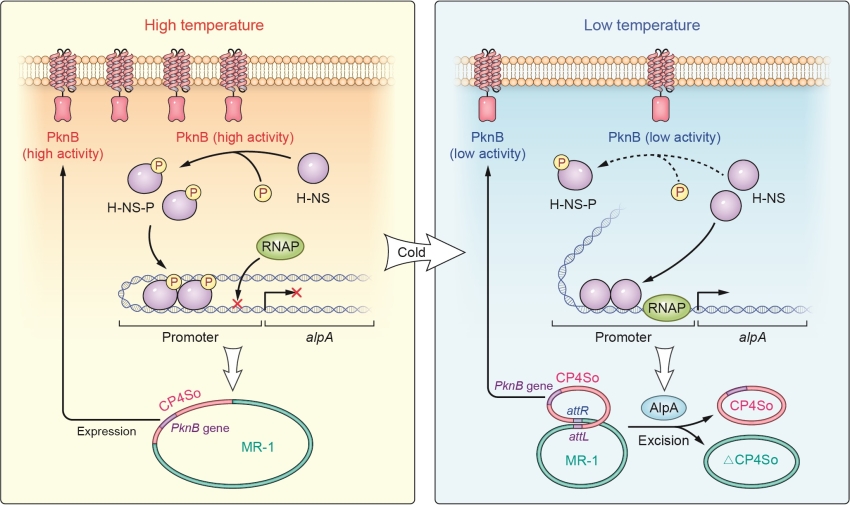Lateral gene transfer (LGT) plays a prominent role in the genome evolution and environmental adaptation of prokaryotes. Xenogeneic silencing proteins can selectively silence the newly acquired DNA molecules to protect cells from the detrimental effects of LGT genes. H-NS, a nucleoid-associated DNA-binding protein, is an important xenogeneic silencer and serves as the “genome sentinel” in Gram-negative bacteria.
Recently, Dr. LIU Xiaoxiao and other researchers in Dr. WANG Xiaoxue’s group from the South China Sea Institute of Oceanology (SCSIO) of the Chinese Academy of Sciences found a key process of xenogeneic silencing by studying Shewanella. The silencing of prophage relies on a temperature-dependent posttranslational modification of the host H-NS in S. oneidensis. This work is the first to show that posttranslational modification of H-NS can function as a regulatory switch to regulate the prophage activity in host genomes. This work was published in Nucleic Acids Research on 8 March,2021.
Researchers from WANG's group showed that H-NS "silences" the prophage by recognizing the excisionase of the prophage. At room temperature, most of the H-NS protein in the cell is phosphorylated. Phosphorylated H-NS can silence the expression of cytotoxic genes on the prophage. However, low temperature promotes the dephosphorylation of H-NS and changes the binding of H-NS to DNA, which reliefs these genes expression. By this way, the H-NS silences the specific prophage and helps Shewanella to adapt to the low temperature environment.
Specifically, phosphorylation of H-NS at Ser42 is critical for silencing the cold-inducible genes including the excisionase of CP4So prophage, a cold shock protein, and a stress-related chemosensory system. By contrast, nonphosphorylated H-NS derepresses the promoter activity of these genes/operons to enable their expression at cold temperatures.
The results of the study illustrate a new way of decision-making for xenogeneic silencing in response to temperature shifts in bacteria and provide new insights for our understanding of how bacteria silence and activates the LGT genes in response to environmental changes.

A proposed mechanism of xenogeneic silencing by H-NS (Image by LIU Xiaoxiao, SCSIO)
Contact: Prof. WANG Xiaoxue, xxwang@scsio.ac.cn
https://academic.oup.com/nar/advance-article/doi/10.1093/nar/gkab137/6163094?guestAccessKey=dcc98bda-2321-4ecf-9519-5797fd35deb2
